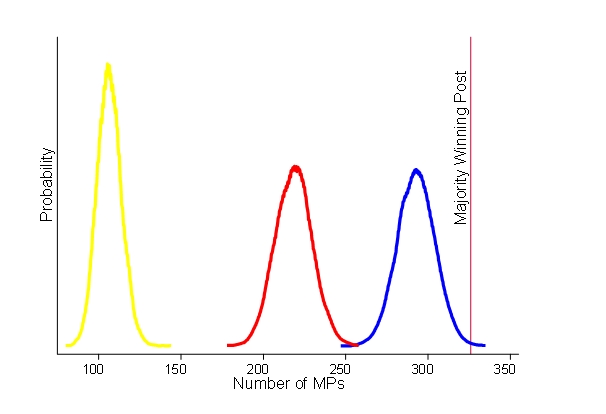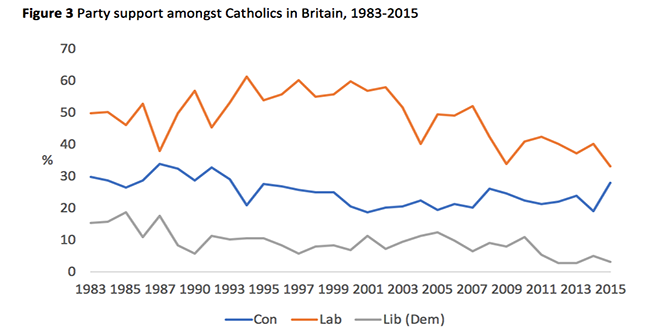Posted by Simon Hix and Nick Vivyan.
We have updated our election prediction model, based on national voting intention results from all polls with fieldwork up to and including 3 May. Here is the updated figure showing the time trends in our pooling-the-polls analysis. The dots in the figure show the results from the various polls and the shaded areas around the lines are the 95 per cent confidence intervals around the mean standings of the parties.

As of 3 May, the national standing of the parties was 34.6 per cent for the Conservatives (up 1.3 per cent from our 26 April analysis), 26.6 per cent for Labour (up 0.1 per cent), and 28.5 per cent for the Lib Dems (down 0.7 per cent). So, over the past week, it looks like the Conservatives have gained slightly, mainly at the expense of the Liberal Democrats, but as in our last predictions all of these changes are within the margin of error.
Here’s how these national vote shares might translate into seats under two different assumptions: (1) a uniform change in party support across constituencies; and (2) differential changes in party support in each region of the country, based on the latest regional polling data from YouGov.
Hix-Vivyan Seat Projections for 5 May
| Hix-Vivyan pooling-the-polls model | Comparison with other predictions | |||
|---|---|---|---|---|
| Assuming a uniform national swing | Assuming different regional swings | electoralcalculus. co.uk (up to 2 May) | ukpollingreport. co.uk (on 3 May) |
|
| Conservatives | 280 | 293 | 317 | 283 |
| Labour | 250 | 218 | 213 | 250 |
| Liberal Democrats | 280 | 107 | 88 | 86 |
| Other | 31 | 32 | 32 | 32 |
| No. of seats Cons short of a majority | 46 | 33 | 9 | 43 |
The Conservatives appear to be getting closer to a majority, although our differential regional-swings model still has them over 30 seats short of the 326 hurdle.
These numbers are the ‘mean’ predictions for each version of our model. To produce these predictions for our differential regional-swings model, we generated a large number of simulations of national vote-share for each party (using our pooling-the-polls method), and for each of these simulations we calculated constituency-level predictions (adjusting for regional deviations from national changes in vote-share, and allowing for constituency level random noise) and aggregated these up to House of Commons seats.
To get a sense of the range of possible outcomes predicted by this method, this figure plots the probability distribution of the number of MPs for each of the three main parties from our differential regional-swings model. Basically, this model predicts that the Conservatives will secure between 271 and 315 seats, that Labour will secure between 197 and 241 seats and that the Liberal Democrats will secure between 93 and 121 seats.

There are, of course, many caveats to these predictions. First, these are based on polls up to 3 May and a lot can happen in the last few days of the campaign, particularly in marginal constituencies, where small last-minute changes in voting intentions can have a large effect on the overall outcome of the election. Second, our model assumes that polling companies are on average correct, which might not be the case in such an exceptionally volatile electoral atmosphere. Third, our models are inherently blunt instruments, and so may not accurately capture the way national vote-shares map into constituency-level results.







